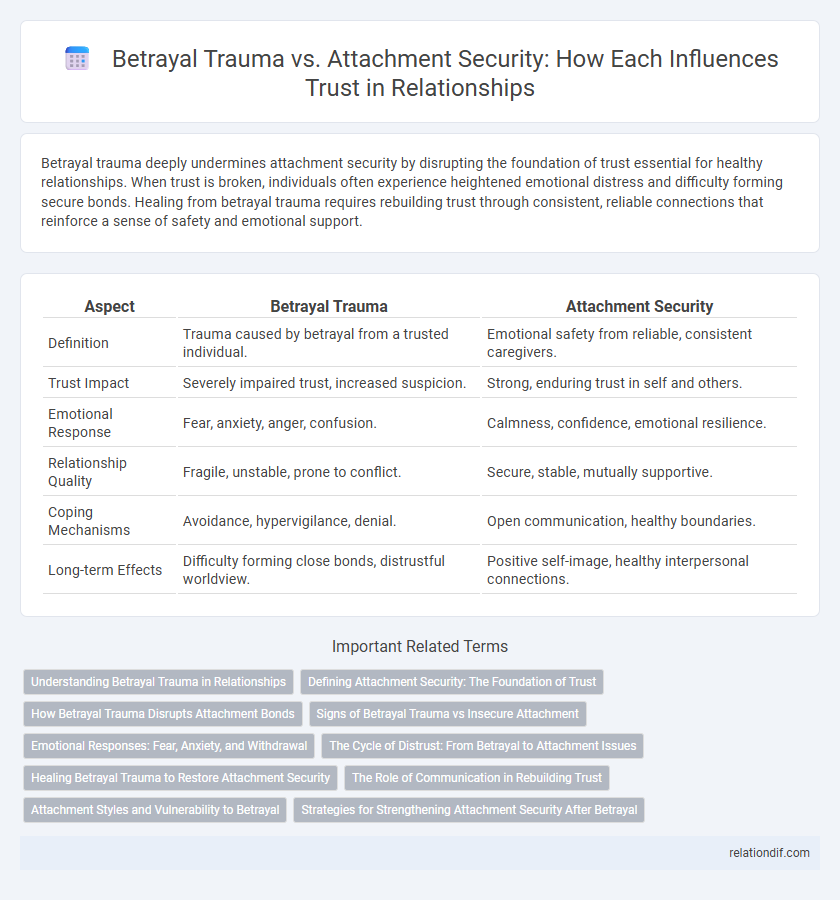Betrayal trauma deeply undermines attachment security by disrupting the foundation of trust essential for healthy relationships. When trust is broken, individuals often experience heightened emotional distress and difficulty forming secure bonds. Healing from betrayal trauma requires rebuilding trust through consistent, reliable connections that reinforce a sense of safety and emotional support.
Table of Comparison
| Aspect | Betrayal Trauma | Attachment Security |
|---|---|---|
| Definition | Trauma caused by betrayal from a trusted individual. | Emotional safety from reliable, consistent caregivers. |
| Trust Impact | Severely impaired trust, increased suspicion. | Strong, enduring trust in self and others. |
| Emotional Response | Fear, anxiety, anger, confusion. | Calmness, confidence, emotional resilience. |
| Relationship Quality | Fragile, unstable, prone to conflict. | Secure, stable, mutually supportive. |
| Coping Mechanisms | Avoidance, hypervigilance, denial. | Open communication, healthy boundaries. |
| Long-term Effects | Difficulty forming close bonds, distrustful worldview. | Positive self-image, healthy interpersonal connections. |
Understanding Betrayal Trauma in Relationships
Betrayal trauma occurs when a trusted partner violates the core expectations of safety and loyalty, severely disrupting attachment security and emotional stability. Understanding betrayal trauma requires recognizing the profound impact it has on trust formation, often triggering symptoms similar to PTSD and impairing the ability to form secure attachments in future relationships. Healing involves therapeutic interventions that address trauma responses while rebuilding attachment security through consistent, reliable relational experiences.
Defining Attachment Security: The Foundation of Trust
Attachment security forms the foundation of trust by fostering a consistent and responsive emotional bond between individuals, essential for healthy relational development. This secure attachment enables individuals to feel safe, valued, and understood, which mitigates the impact of betrayal trauma by promoting resilience and emotional regulation. Establishing attachment security early in life contributes to a stable framework for trust, reducing the vulnerability to relationship disruptions caused by betrayal.
How Betrayal Trauma Disrupts Attachment Bonds
Betrayal trauma significantly disrupts attachment bonds by undermining the fundamental trust necessary for secure relationships, often causing emotional withdrawal and hypervigilance. This trauma impairs the brain's ability to regulate emotions and process social cues, leading to difficulties in forming or maintaining consistent, healthy attachments. As a result, individuals with betrayal trauma may experience heightened anxiety and avoidance in intimate relationships, contrasting sharply with the stability provided by attachment security.
Signs of Betrayal Trauma vs Insecure Attachment
Betrayal trauma often manifests through symptoms like hypervigilance, emotional numbness, and difficulties in trusting others due to experiencing profound violations by trusted individuals. In contrast, insecure attachment is characterized by fear of abandonment, anxiety in relationships, and inconsistent emotional responses rooted in early caregiver interactions. Identifying emotional dysregulation and persistent relational mistrust helps differentiate betrayal trauma from attachment insecurity in clinical assessments.
Emotional Responses: Fear, Anxiety, and Withdrawal
Betrayal trauma often triggers intense emotional responses such as fear, anxiety, and withdrawal, disrupting one's sense of safety and trust. Attachment security, in contrast, fosters resilience by promoting emotional regulation and a sense of stability, reducing the impact of these negative states. Understanding the interplay between betrayal trauma and attachment security is crucial for effective therapeutic interventions targeting emotional healing.
The Cycle of Distrust: From Betrayal to Attachment Issues
Betrayal trauma disrupts the brain's trust mechanisms, leading to a cycle of distrust that impairs secure attachment development. When betrayal occurs, individuals often experience heightened anxiety and emotional dysregulation, reinforcing attachment insecurities and mistrust in relationships. This cycle perpetuates difficulties in forming healthy emotional bonds, as the neural pathways associated with safety and trust become compromised.
Healing Betrayal Trauma to Restore Attachment Security
Healing betrayal trauma involves rebuilding trust through consistent, empathetic communication and emotional safety, which directly supports restoring attachment security in relationships. Therapeutic approaches such as trauma-informed therapy and emotionally focused therapy target disruptions in attachment patterns caused by betrayal, fostering resilience and emotional regulation. Strengthening attachment security after betrayal trauma enables individuals to develop healthier relational bonds and foster long-term emotional stability.
The Role of Communication in Rebuilding Trust
Effective communication plays a crucial role in rebuilding trust after betrayal trauma by fostering openness and emotional safety that support healing attachment security. Transparent dialogue allows individuals to express vulnerabilities and clarify misunderstandings, which mitigates the fear and mistrust anchoring betrayal trauma. Consistent, empathetic communication re-establishes predictable patterns of interaction, strengthening attachment bonds and facilitating long-term trust restoration.
Attachment Styles and Vulnerability to Betrayal
Attachment styles significantly influence vulnerability to betrayal trauma, with insecure attachments--such as anxious or avoidant--heightening susceptibility due to impaired trust and emotional regulation. Secure attachment fosters resilience by promoting healthy interpersonal boundaries and adaptive coping mechanisms when faced with betrayal. Understanding the interplay between attachment security and betrayal trauma is crucial for developing therapeutic interventions aimed at restoring trust and emotional safety.
Strategies for Strengthening Attachment Security After Betrayal
Rebuilding attachment security after betrayal trauma involves consistent emotional availability and transparent communication to restore trust and safety within relationships. Therapeutic approaches such as trauma-informed cognitive-behavioral therapy (CBT) and emotion-focused therapy (EFT) help individuals process trauma while fostering secure attachment patterns. Incorporating mindfulness practices and strengthening social support networks further enhances resilience and promotes healing from attachment disruptions caused by betrayal.
Betrayal Trauma vs Attachment Security Infographic

 relationdif.com
relationdif.com